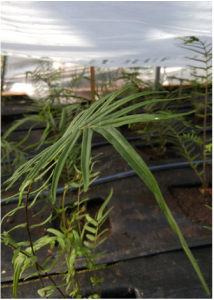 The last ferns gets planted in late afternoon light by intern Elizabeth Fernandez. The last ferns gets planted in late afternoon light by intern Elizabeth Fernandez. In a flurry of puns and pizza, we recently planted 900 Pteris vittata ferns in 36 plots at my new field site in Richmond, CA. End result: a fully fernished greenhouse (right). Broadely, the goal of the project is to see how we can increase arsenic uptake in P. vittata, a known arsenic hyperaccumulator, in order to use the fern for remediation purposes, a process known as phytoremediation. As we planted we not only experienced a connection to living things, but also implemented remediation technology. Ultimately, however, the planting was a job that would only get done with a team effort, a community spirit reminiscent of a barn-raising. I am immensely grateful for the great team work on the part of my interns and the support of fellow graduate students, culminating in an amazing effort of up to 10 people working over 5 workdays to get all the ferns in the ground. By the time I had carefully prepared my soil for planting, the ferns were long pot-bound in their 4” pots. Popping the ferns out of the pots revealed a nice pot-shaped web of roots, light green root tips emerging from the tight web of rich brown. Planted in that state, the roots would not really penetrate the soil, the ability of the plant to take up arsenic from the soil would be limited, and my arsenic phytoextraction data would be affected. I had encountered a similar problem when starting a greenhouse experiment, and in that case I had successfully washed the soil out of the roots and disturbed the bound root ball with little apparent harm to the plant. Now, I decided to build up that technique to the industrial scale, by slicing and then power washing the root mass to quickly and efficiently free up the roots. Although this treatment seemed violent, I thought the ferns would survive and even benefit, based on my experience in the greenhouse study. The fern could be in a group of plants that responds to root pruning by producing new "compensatory" root growth (Andersen 1987). Removing the potting soil would be an added benefit, increasing the contact between the roots and the arsenic-contaminated soil. To power-wash the roots, we set up 3 power washing stations with the power washers ensconced in bright green rain suits. Some people really enjoyed that job (see photo below)! However, the challenge would be preventing the ferns from wilting while the roots were disturbed. We did the root treatment immediately before planting and kept the ferns in buckets of water. The greenhouses were covered in 60% shade cloth, but some areas of the greenhouse near the front received more light, so we wanted to make sure all ferns were kept well shaded as they recovered from transplant shock. After planting, we covered the plants with floating row cover (see photo below) and misted them to keep them in a cool and humid environment for the first few days while the roots started growing. Wilting happens when there is more transpiration than water intake – likely to occur after root disturbance. Herbaceous (non-woody) plants wilt when they lose their turgor pressure, the pressure created by water in cell vacuoles and in plant xylem. The water stored in the vacuole presses out on the cell wall and creates the turgor pressure, which causes the plant to remain erect. However, when the plant is not taking in enough water through its roots, the vacuoles are not full and the plant loses its turgor pressure and wilts. Plants can recover from wilting as long as the cell walls are strong enough to retain their shape. However, new growth, like unfurling fiddleheads and young fronds on our ferns, is at risk of not being able to recover since the young cell walls are more fragile. Our goal was to prevent the young growth on our ferns from wilting, even with significant root disturbance. A few ferns receiving the most sun wilted, but immediately bounced back once covered with floating row cover and misted, which limited transpiration. Overall, we didn’t lose any new growth, let alone whole plants, a real success when planting out 900 plants. Now, several weeks later, fiddleheads are unfurling, fronds are spreading out. The ferns are acclimating to their new home, growing into their new life as research subjects! Andersen 1987. Below-Ground Herbivory in Natural Communities: A Review Emphasizing Fossorial Animals The Quarterly Review of Biology Vol. 62, No. 3 (Sep., 1987), pp. 261-286
3 Comments
8/1/2022 02:42:28 am
Sosyal medya hesapları için Türk ucuz takipçi satın al seçenekleri yer alıyor. Bu seçeneklerin hepsini incelemek veya satın almak için adresimize giriş yapabilirsiniz.
Reply
8/1/2022 05:25:48 am
Güvenilir ve kaliteli bir takipçi hizmeti arıyorsanız doğru adrestesiniz. Türk takipçi satın almak seçeneği ile hızlı bir şekilde bu ayrıcalıklardan yararlanmak için sayfamıza bekliyoruz.
Reply
Leave a Reply. |
AuthorSarick Matzen completed his PhD in Environmental Science, Policy, and Management department at University of California, Berkeley in 2020. He is now a postdoc in the Soil, Water, and Climate Department at the University of Minnesota working on iron cycling in marine systems. Archives
July 2019
Categories |



 RSS Feed
RSS Feed
